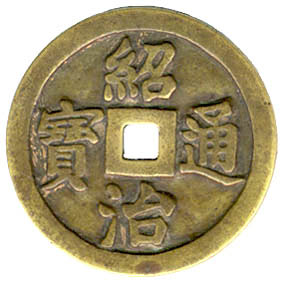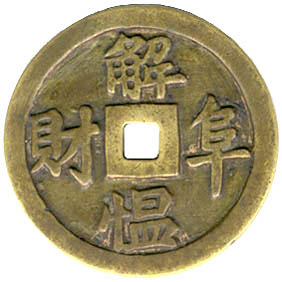(or Thieu Tri Thong Bao)
Legend on the reverse with 4 Chinese characters
"Chieh Yun Fu T'sai"

| Home Page 主頁 |
New Data 最新資料 |
Chronology 歷史編年表 |
HK/Macao 港澳錢幣 |
Cast Coins 中國古錢 |
Struck Coins 機鑄幣 |
Paper Money 紙幣 |
Values/Wants 估值及征購 |
Links/References 網站參考鏈接 |

I received an e-mail from Mr. R. Trieu of U.S.A. on 11 Nov 1999. When I looked at the attached images of his coin, I felt ashamed that I did not know the meaning of the four Chinese characters "Chieh Yun Fu T'sai"  on the reverse. What I knew is that these four Chinese characters are come from "Sze-Shu Wu-Ching" on the reverse. What I knew is that these four Chinese characters are come from "Sze-Shu Wu-Ching"  [The Four Books and The Five Clasics which were compiled by the famous scholar, [The Four Books and The Five Clasics which were compiled by the famous scholar,  Chu Hsi of the Southern Sung Dynasty ] Therefore, I spent almost two hours to find out the meaning of this idiom.
I post below is the email from Mr. R Trieu of U.S.A. Chu Hsi of the Southern Sung Dynasty ] Therefore, I spent almost two hours to find out the meaning of this idiom.
I post below is the email from Mr. R Trieu of U.S.A.
Date: Thu, 11 Nov 1999 21:47:33 From: Mr. R. Trieu Subject: Unknown Large Chinese Cash Coin
Dear Sir,
|
| Obverse | Reverse | Description |
 |
 | No. 321 |
| Diam. 52 mm | ||
| Thickness 1.5 mm | ||
| Hole 8 mm | ||
| Wt. 26.56g. | ||
| Rareness B | ||
| Mint Evolution and Peculiarity | ||
|
This Annamese cash is not only a rare coin, but also the coin itself appearing in an extremely fine condition. I have never seen an Annamese cash (big cash) appearing in such a perfect way.
This cash coin is known as Shao Shih T'ung Pao (or Thieu Tri Thong Bao).
The legends on both side of this cash are read in the normal manner, top, bottom, right and left. | ||
| Home Page 主頁 |
New Data 最新資料 |
Chronology 歷史編年表 |
HK/Macao 港澳錢幣 |
Cast Coins 中國古錢 |
Struck Coins 機鑄幣 |
Paper Money 紙幣 |
Values/Wants 估值及征購 |
Links/References 網站參考鏈接 |